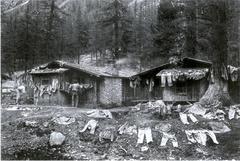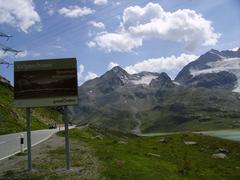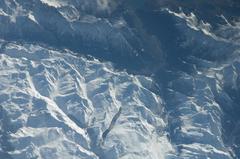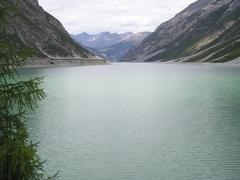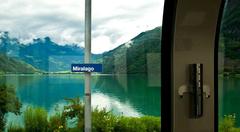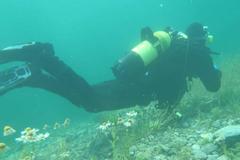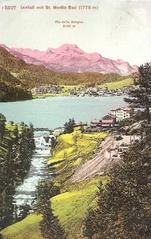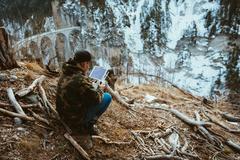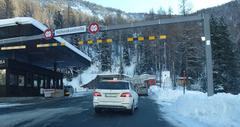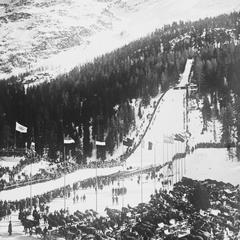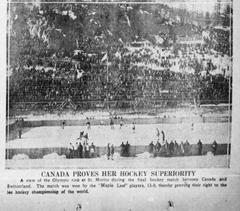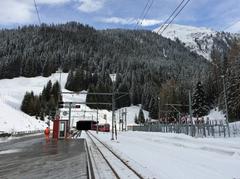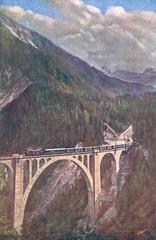Lai Da Curnera Visiting Hours, Tickets, and Travel Guide in Canton of the Grisons, Switzerland
Date: 04/07/2025
Introduction
Lai da Curnera, nestled within the dramatic Swiss Alps in the Canton of the Grisons (Graubünden), is a remarkable alpine reservoir celebrated for its breathtaking landscapes and its central role in Swiss hydropower heritage. Built between 1962 and 1966, this dual-curve arch dam not only exemplifies Switzerland’s engineering prowess but also contributes significantly to the nation’s renewable energy portfolio, particularly in terms of winter energy reserves (Axpo; Wikipedia).
Surrounded by peaks soaring above 3,000 meters, Lai da Curnera is a haven for hikers, cyclists, photographers, and nature lovers. Although its origins are industrial, the site has been harmoniously integrated into the local ecosystem and cultural landscape. Visitors can explore this unique intersection of nature, technology, and sustainability, while enjoying outdoor adventures and immersing themselves in the rich heritage of the Grisons region (Unterwegs SOB; gr.ch).
The reservoir is open year-round, with the optimal visiting period from late spring through early autumn. Access is predominantly by foot or bicycle from the Oberalp Pass road; private vehicles are restricted to safeguard the fragile alpine environment (Axpo). There is no entrance fee, and free guided tours of the hydropower facilities are available through advance booking, offering visitors an inside look at the site’s technological achievements.
Table of Contents
- Historical Context and Hydropower Development
- Visiting Lai da Curnera: Hours, Tickets, and Accessibility
- Recreational Activities and Visitor Experience
- Cultural Highlights & Sustainable Tourism in the Grisons
- Summary and Visit Tips
- References and Further Reading
Historical Context and Hydropower Development
Early Hydropower Ambitions in the Swiss Alps
The Swiss Alps have long been recognized for their hydropower potential. In the post-war era, Switzerland expanded efforts to harness alpine water resources, ensuring energy security and supporting economic growth. The area around the Oberalp Pass, including the Curnera valley, was identified as ideal due to its altitude, reliable snowmelt, and proximity to the Vorderrhein river system (Axpo).
Construction and Interconnected Reservoir System
Timeline and Engineering:
Lai da Curnera was built between 1962 and 1966, with the dam completed in 1966 (Wikipedia). This period marked a significant expansion of Swiss hydropower, with the project forming part of a triad alongside Lai da Nalps and Lai da Santa Maria, all managed by Kraftwerke Vorderrhein AG (Axpo).
Dam Specifications:
Curnera’s dual-curve arch dam stands 153 meters high and 350 meters long, holding up to 40.8 million cubic meters of water and covering 82 hectares at 1,956 meters above sea level (Axpo; Wikipedia).
System Integration:
Lai da Curnera is connected to the nearby Nalps and Santa Maria reservoirs by tunnels and transfer lines through the Gotthard Massif, allowing water to be managed efficiently across a 315.8 km² catchment area (Axpo; Latitude.to).
Socio-Economic and Environmental Impact
Construction led to significant transformations in the alpine landscape, with uninhabited valleys submerged and roads rerouted, notably at Lai da Santa Maria (Axpo). Over time, the turquoise waters and dramatic dam have become integral to both the ecosystem and regional identity (Unterwegs SOB).
Hydropower Production and Innovation
The Kraftwerke Vorderrhein system includes major plants at Sedrun and Tavanasa, with a combined annual output of approximately 840 million kWh—vital for Switzerland’s winter energy needs (Axpo). Recent innovations include a 2.5 MW Francis turbine at Curnera, generating up to 10 million kWh per year. Studies are underway to further expand capacity by raising dam heights.
Historical and Cultural Significance
Lai da Curnera is more than an engineering feat. It is featured in popular culture (e.g., the film “Edge of Tomorrow”) and stands as a symbol of Swiss resilience and self-sufficiency (Wikipedia). The site’s legacy continues to inspire visitors with its blend of technological innovation and alpine tradition.
Visiting Lai da Curnera: Hours, Tickets, and Accessibility
Hours and Access
- Open: Year-round; best visited from May to October.
- Hours: Daylight (typically 8:00 AM–6:00 PM), varying with season and weather.
- Access: By foot or bicycle from the Oberalp Pass road; private vehicles are not allowed (Unterwegs SOB).
Tickets and Guided Tours
- Entry Fee: None.
- Guided Tours: Free, by advance booking (minimum 8 people) via Sedrun Disentis Tourist Office, every Thursday (Axpo).
Accessibility
- Terrain is mountainous, with well-marked but sometimes steep trails—best suited for those with moderate fitness.
- No wheelchair-accessible paths currently available.
- Wear appropriate hiking gear and check forecasts before visiting.
Visitor Resources
- No on-site visitor center; information is available from the Sedrun Disentis Tourist Office and online resources.
Recreational Activities and Visitor Experience
Hiking and Walking
Lai da Curnera is renowned for its diverse hiking trails, suitable for all levels:
- Challenging: Lai Carin – Maighelshütte loop (17.7 km, ~8 hours, 1,200 m elevation gain) (Komoot).
- Moderate: Milez – Piz Badus loop (17.0 km, 5 hours, 590 m elevation gain).
- Family-Friendly: Magnificent view of Piz Badus – Milez-Punkt 1876 loop (5.53 km, 1 hour 44 min).
Cycling and Mountain Biking
Cyclists can enjoy both challenging ascents and scenic rides along gravel and paved trails, including segments of the Alpenbrevet Extended (Komoot).
Running and Trail Running
The tranquil environment and well-maintained paths make the area suitable for both casual joggers and serious trail runners.
Picnicking and Relaxation
Designated picnic areas near the dam and along trails provide scenic spots for relaxation amidst alpine beauty (Evendo).
Photography and Nature Observation
The reservoir’s turquoise waters and surrounding peaks offer stunning photography opportunities, especially at sunrise and sunset. Alpine wildlife—including marmots and ibex—can be observed along the trails.
Facilities
The area remains largely unspoiled, with basic amenities such as parking and picnic spots. Visitors should bring their own provisions, as commercial facilities are limited.
Seasonal Activities
While summer is ideal for hiking and cycling, winter brings opportunities for snowshoeing and winter hiking. Nearby resorts offer winter sports for those seeking more adventure (Together in Switzerland).
Cultural Highlights & Sustainable Tourism in the Grisons
Multilingual and Multicultural Identity
The Grisons is Switzerland’s only trilingual canton—German, Romansh, and Italian are all official languages (gr.ch). This diversity is reflected in signage, festivals, and daily life, enriching the visitor experience.
Cultural and Historical Context
The Tujetsch valley, near Lai da Curnera, is known for its alpine farming traditions and organic agriculture. Visitors can experience this heritage through local foods, customs, and architecture (claudiatravels.com).
Sustainable Tourism and Environmental Stewardship
The Grisons is a leader in sustainable tourism, with extensive protected areas and eco-friendly initiatives (gr.ch; axpo.com). Public transport is highly recommended, and visitors are encouraged to follow Leave No Trace principles.
Responsible Outdoor Activities
With over 11,000 km of marked trails, the region offers abundant opportunities for hiking, cycling, and wildlife observation, all within a framework that prioritizes environmental protection (claudiatravels.com).
Summary and Visit Tips
Lai da Curnera stands as a symbol of Switzerland’s innovation in hydropower and commitment to preserving the natural and cultural treasures of the Grisons. Since its completion, the reservoir has played a vital role in energy production, while offering visitors an immersive alpine experience. The region’s multilingual heritage, sustainable tourism practices, and breathtaking scenery make every visit rewarding (Axpo; gr.ch; claudiatravels.com).
Visitor Tips:
- Visit between late spring and early autumn for the best conditions.
- Use public transportation or hike/cycle to minimize your environmental impact.
- Reserve guided tours in advance if interested in hydropower operations.
- Respect the pristine environment and local customs.
- Download the Audiala app for up-to-date information, offline maps, and personalized guides.
Frequently Asked Questions (FAQ)
Q: Can I visit Lai da Curnera year-round?
A: Yes, but access is easiest from May to October due to snow in winter.
Q: Are there entrance fees or tickets?
A: No, entry is free. Guided tours require advance booking.
Q: How do I get there?
A: By hiking or cycling from Oberalp Pass or nearby villages. Public transport is available to trailheads.
Q: Are there facilities on-site?
A: The area is largely natural; bring your own supplies.
Q: Is the site accessible for those with limited mobility?
A: The terrain is steep and not wheelchair-accessible.
References and Further Reading
- Axpo Magazine, 2024, Axpo Holding AG
- Lac de Curnera, 2024, Wikipedia
- Unterwegs SOB: Runda Curnera, 2024, Südostbahn AG
- Lai da Curnera Hiking Guide, 2024, Komoot
- Grisons Canton Official Website, 2024, Canton of Grisons
- Claudiatravels: Things to Do in Grisons, 2024
- Evendo: Staudamm Lai da Curnera, 2024
- Together in Switzerland: Grisons Overview, 2024
- Climbfinder: Lai da Curnera Oberalppass, 2024
